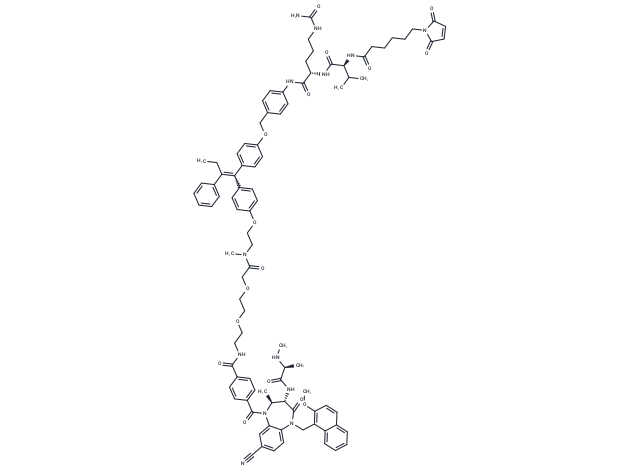Shopping Cart
- Remove All
 Your shopping cart is currently empty
Your shopping cart is currently empty

PAC is a chemical conjugate consisting of an ADCs linker and PROTACs linked to an antibody. When PAC is conjugated to an antibody, it exhibits enhanced degradation of estrogen receptor-alpha (ERα) in comparison to PROTAC alone.

| Pack Size | Price | Availability | Quantity |
|---|---|---|---|
| 100 mg | Inquiry | Backorder | |
| 500 mg | Inquiry | Backorder |
| Description | PAC is a chemical conjugate consisting of an ADCs linker and PROTACs linked to an antibody. When PAC is conjugated to an antibody, it exhibits enhanced degradation of estrogen receptor-alpha (ERα) in comparison to PROTAC alone. |
| In vitro | Treatment with the HER2 antibody-containing PAC Anti-HER2(Endox-XIAP) significantly reduces Estrogen Receptor-alpha (ERα) levels in HER2-expressing cells, achieving an IC50 value of 132 ng/mL. This effect is attributed to the structure of the PROTAC-Antibody Conjugate (PAC), which consists of an antibody linked via a linker (L1) to a PROTAC. This PROTAC includes an ubiquitin E3 ligase binding group ('E3LB'), a secondary linker ('L2'), and a protein binding group ('PB'). Key components of the PAC include: 1. The antibody (Ab), which targets cells expressing a specific antigen, facilitating the intracellular delivery of the PAC, mainly through endocytosis, although in cases where the antigen is not on the cell surface, pinocytosis may occur. 2. The linker (L1), a bifunctional or multifunctional entity that connects the PROTAC moieties (D) to the antibody, allowing for the construction of the PAC through reactive functionalities. 3. The PROTAC (D), central to the PAC's mechanism, targeting specific cellular proteins for degradation to exert a therapeutic effect. These components are carefully engineered to ensure potent efficacy and a desirable therapeutic index of the PAC. |
| Molecular Weight | 1674.965 |
| Formula | C94H107N13O16 |
| Cas No. | 2158322-33-7 |
| Relative Density. | 1.33 g/cm3 (Predicted) |
| Storage | Powder: -20°C for 3 years | In solvent: -80°C for 1 year | Shipping with blue ice. | ||||||||||||||||||||||||||||||
| Solubility Information | DMSO: 100 mg/mL (59.70 mM), Sonication is recommended. | ||||||||||||||||||||||||||||||
Solution Preparation Table | |||||||||||||||||||||||||||||||
DMSO
| |||||||||||||||||||||||||||||||

Copyright © 2015-2025 TargetMol Chemicals Inc. All Rights Reserved.